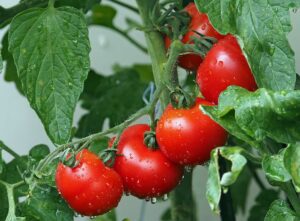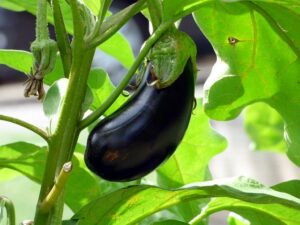Introduction
[Update 03/02/2024: we updated many of the culturing tips in the 10 vegetables]
ShrinkThatFootprint is an advocate for growing your own vegetables. Transport of food from non-local sources is a big contributor to the food component of our carbon emissions. Growing your own vegetables is a way to get around the transport carbon cost. Plus, you’d be generating food from free sunlight and air! One of the things we’ve covered before is growing your own vegetables.

Vegetables are a great source of nutrients that can help you stay healthy. They’re low in calories and fat and packed with vitamins, minerals, and fiber. Eating a diet rich in vegetables can help you lose weight, possibly lower your risk for certain diseases, and improve your overall health. If you have a spot to grow vegetables that get a lot of direct sun, you should consider planting a few specific vegetables. Vegetables that grow in full sun are full of nutrients and flavor, and they’re also some of the most popular vegetables people grow.
Tips for Sun-loving Vegetables
The best vegetables to grow in the direct sun include tomatoes, peppers, eggplants, squash, and beans. These vegetables love the heat and will do best when they get plenty of sunlight. If you’re not sure what varieties of these vegetables to grow, talk to your local nursery or garden center. They can help you choose the right plants for your area.
If you want to get the most out of your vegetable garden, it’s important to choose the right plants. Some vegetables are better suited for growing in the direct sun than others. Make sure to select varieties that will do well in your climate and get the right amount of sunlight. With a little planning, you can grow a bounty of fresh vegetables that will make your meals taste even better.
10 Vegetables That Grow In Full Sun
Many vegetables need full sun to grow well, which means they need at least 6-8 hours of direct sunlight each day. If you’re planning to grow vegetables in your garden, it’s important to choose varieties that will thrive in the amount of sunlight you have available. Some vegetables that grow well in full sun include tomatoes, peppers, cucumbers, squash, eggplant, and beans.
Full sun also helps promote strong fruit production and rich flavor in vegetables. If you live in an area with limited sunlight, you may still be able to grow some of these vegetables by choosing varieties that are bred to produce fruits and vegetables with less sunlight. With a little research, you can find the perfect vegetables for your garden, regardless of the amount of sunlight available. Here are 10 vegetables that grow well in full sun:
1. Tomatoes
Tomatoes are one of the most popular vegetables to grow in home gardens. They are relatively easy to care for and can provide a bountiful harvest with proper care. One of the key requirements for growing tomatoes is full sun. Tomatoes need at least six hours of direct sunlight per day to produce an abundance of fruit.
The more sun they receive, the better they will grow. Tomatoes will also likely need to be watered more frequently when grown in full sun. However, too much water can also be detrimental to tomato plants, so it is important to find a balance. Tomatoes that receive too little sun may produce fewer fruit, and the fruit that is produced may be smaller and less flavorful.
2. Peppers
Peppers need at least six hours of direct sunlight daily to grow well. If they don’t get enough sun, they’ll produce fewer peppers, and the peppers they produce will be smaller. Peppers also need fairly warm temperatures to grow well. They won’t tolerate frost, so it’s best to wait until all danger of frost has passed before planting them outdoors. Peppers are fairly easy to grow and a great vegetable to add to your garden. You can enjoy a bountiful harvest of delicious peppers with a little care.
3. Cucumbers
Cucumbers are vegetables that grow in full sun because they need a lot of sunlight to produce fruits. Cucumbers are vines that can grow up to six feet long. The plants have large green leaves and small yellow flowers.
Spacing and trellising are for air circulation and disease prevention, which is due to cucumbers vine nature.
Cucumbers are usually harvested in the summer when they are about six inches long. Cucumbers can be eaten raw or pickled. They are a good source of vitamins C, and K. Cucumbers are also used in some skin care products because of their moisturizing properties.
4. Squash
Squash are vegetables that grow in full sun. Squash needs at least six hours of direct sunlight daily to produce fruit, and they prefer soil high in organic matter. Squash also requires consistent watering, especially when the fruits are forming.
Squash can be susceptible to several pests and diseases, but you can control most problems with good cultural practices. Common issues are squash vine borers or powdery mildew.
Squash is generally easy to grow and makes an excellent addition to the home garden. With such wide different varieties available, there is sure to be a squash that will fit your taste and gardening style.
5. Eggplant
Eggplant is a vegetable that grows in full sun because they need a lot of sunlight to produce fruit. Eggplant is usually started from transplants rather than seeds. Eggplant does best in warm weather and needs consistent moisture to produce fruit. Eggplants can be harvested when the fruit is firm and glossy. You can use eggplant in many recipes, including Eggplant Parmesan and ratatouille. Eggplant can also be roasted and eaten as a side dish. Roasting eggplant brings out its natural sweetness.
Eggplant is a versatile vegetable that you can use in many different ways. Eggplants, like tomatoes, are also said to need 6 hours of full sunlight per day. You’ll find that the spring to summer months are probably enough to grant that many hours of sunlight per day, starting from March onwards. But remember that it takes time to grow to full size so you’ll have to make sure that you get a sufficiently long head start so that there continues to be full sun until the time of harvesting which for eggplants takes 3-4 months.
6. Beans
Beans are the vegetables that do best when they get lots of suns. They need sunlight for at least six hours daily to produce a good crop. Beans also need warm weather to grow well. Beans will not tolerate frost or cold weather and in fact beans should be planted after the soil has warmed to an appropriate temperature for germination.
Beans need well-drained soil that is high in organic matter. Beans are a good source of protein and fiber. They are also low in fat and calories. You can use beans in many different recipes, such as soups, stews, chili, and salads. Beans can also be ground into flour and used to make bread and pastries.
7. Corn
Corns are vegetables that grow in full sun because they need at least eight hours of sunlight per day to produce a good crop. Corn is a warm-season crop, so it is best planted in late spring, or early summer after the danger of frost has passed. Corn is a very versatile vegetable and can be used in many different dishes.
It can be boiled, roasted, grilled, or even eaten raw. Corn is also a good source of vitamins and minerals, including vitamin C, thiamin, and folate. Corn is a popular food all over the world and is enjoyed by people of all ages.

8. Pumpkin
Pumpkins are one of the most popular vegetables in the world. They are usually orange or yellow and have a hard outer shell. Pumpkins grow in full sun, and they need a lot of space to grow. Pumpkins are usually planted in the spring, taking about three months to mature. Pumpkins need a lot of water, and you should water them regularly. When pumpkins are ripe, they can be harvested. Pumpkins can be used to make pies, bread, soups, and other dishes.
9. Okra
Okras are vegetables that grow in full sun and require well-drained, fertile soil. They are heat-loving plants that are sensitive to cold temperatures and frost. Okras are usually started from seedlings, although they can also be grown from seeds.
Okras can be grown in pots or containers as long as they are well-ventilated and have good drainage. Okras typically produce yellow flowers that turn into green pods. The pods can be cooked and eaten when they are young and tender. Okra plants mature within 60 to 90 days, which is typical like the other vegetables featured here.
10. Sweet Potatoes
Sweet potatoes are a type of vegetable often cultivated in sunny areas. This is because sweet potatoes require a lot of sunlight to grow properly. Sweet potatoes need at least six hours of sunlight daily to produce the maximum yield, and best if put into warm soil for optimal growth. They are planted using slips (shoots grown from mature sweet potatoes) rather than seeds.
Sweet potatoes grown in shady areas tend to be smaller and have lower sugar content. They can be baked, mashed, boiled, or roasted. You can also use sweet potatoes to make soup, bread, pie, and casserole. Sweet potatoes are a healthy and delicious addition to any meal. Sweet potatoes will take 3-4 months to mature.
Wrapping Up
In conclusion, these vegetables are some of the many that do best when grown in full sun. Full sun exposure is important for these vegetables to grow properly and yield a good crop. These vegetables need at least six hours of sunlight each day and require well-drained, fertile soil. Sweet potatoes, corn, beans, eggplant, pumpkin, and okra are all popular vegetables that are enjoyed by people all over the world. So if you’re looking to add some delicious and nutritious vegetables to your diet, consider growing some sun-loving vegetables in your garden.
